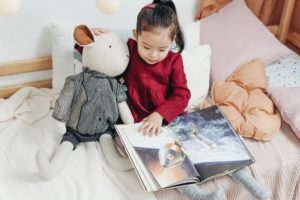Let’s face it. None of us expected to be living in a sci-fi thriller during 2020: COVID pandemic, civil unrest, election disputes, distance learning, economic struggles, and the list goes on. How do we make sense out of the chaos? Stories.
Bruno Bettleheim studied fairy tales, and he asserts that these fantastical stories offer children “ideas on how to bring their inner house into order.” Think of Hansel and Gretel, Jack and the Beanstalk, The Ugly Duckling. These tales paint a picture of good and bad, right and wrong. Through trials, either internal or external, and journeys, whether familiar or mysterious, the characters come face-to-face with their strengths and weaknesses. As their self-awareness grows so does their understanding of their personal power to make choices that change the course of life for themselves and others. At the end of the tale, they emerge as new and hopeful creatures, forged by hardship.
 In their book The Whole Brain Child (2011), Siegel and Bryson say this:
In their book The Whole Brain Child (2011), Siegel and Bryson say this:
“When children learn to pay attention to and share their own stories, they can respond in healthy ways to everything from a scraped elbow to a major loss or trauma. What kids often need, especially when they experience strong emotions, is to have someone help them use their left brain to make sense of what’s going on – to put things in order and to name these big scary right-brain feelings so they can deal with them effectively… stories empower us to move forward and master moments when we feel out of control. When we give words to our frightening painful experiences – when we literally come to terms with them – they often become much less frightening and painful.” (emphasis mine)
Siegel and Bryson are calling us, as caring adults, to ask children to tell us their stories and then listen. There is such power in being present.
 How do we make the connection between reading stories to children and listening to children’s personal stories? Here are some tips that can be used with face-to-face and virtual interactions:
How do we make the connection between reading stories to children and listening to children’s personal stories? Here are some tips that can be used with face-to-face and virtual interactions:
- Start with a good book. Whether you choose a classic or contemporary fiction, select a story that is rich with intrigue.
2. Read with passion. Children enjoy your character voices. Don’t be shy!
3. Ask questions. For longer stories, ask questions along the way about what they think will happen next. For shorter stories, ask questions about how the character changed or what they themselves learned.
4. Connect the dots. Gently guide children to the awareness of how the story relates to their own lives.
5. Invite them to share their own stories. Sharing our personal stories can happen in a variety of ways. It can happen in a circle or on screen, with one person talking as others are listening. It can also happen through journaling, painting, movie-making, or graphic design. Considering your supplies, provide opportunities for children, from PreK through middle school, to express themselves.
 One of the most important lessons I hope all of us carry forward from this unprecedented year is that we are in this together. Stories are a powerful tool for strengthening connections and building relationships between caring adults and children as well as children and their peers. We need each other!
One of the most important lessons I hope all of us carry forward from this unprecedented year is that we are in this together. Stories are a powerful tool for strengthening connections and building relationships between caring adults and children as well as children and their peers. We need each other!
For more ideas about using stories to connect with children and teach social-emotional learning skills, visit www.loveinabigworld.org.
For breakfast, I had Trader Joe’s Green Juice and two pieces of dark chocolate.
Author: @tamarafyke
